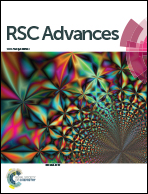Urea based organic nanoparticles for selective determination of NADH†
Abstract
Dipodal receptor 1 was synthesized using a single step procedure. The prepared receptor was subjected to organic nanoparticles (N1) and its sensor activities were tested with various biomolecules on the basis of changes in its photo-physical properties. Receptor responded selectively for reduced nicotineamide adenine dinucleotide; with a linear detection range upto 340 nM, having a detection limit of 96 nM, selective determination of NADH using N1 was not affected by the presence of any other potential interfering biomolecule or even in the presence of a higher concentration of salt.


 Please wait while we load your content...
Please wait while we load your content...